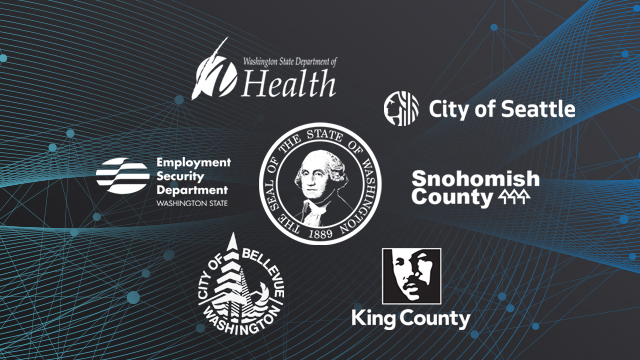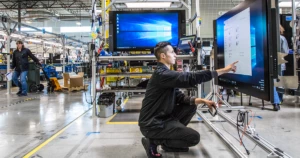
Washington governments respond to COVID-19 with Microsoft chatbots

With the U.S. Centers for Disease Control and Prevention confirming the first U.S. reported case of coronavirus in Washington on Jan. 21, it’s not surprising that the Evergreen State was proactive in battling the fast-spreading illness. Microsoft’s response to the COVID-19 pandemic was equally swift in our home state, where we partnered with agencies on the front lines to quickly and securely deploy conversational chatbots, powered by the trusted Azure cloud, artificial intelligence and Bot Service. U.S. state and local governments have deployed 30 of these capable chatbots, supporting more than 10 million conversational experiences and serving a population of over 73 million users. These six examples of innovation in Washington show how chatbots enable government continuity and deliver much-needed support and information to the public and employees.
Washington State Department of Health
When COVID-19 first appeared in Washington, the state Department of Health (DOH) was at the forefront of the emerging pandemic. As the disease spread, one of the critical aspects of prevention was providing timely and accurate information to residents.
With Microsoft offering infrastructure support, the “COVID-19 Questions?” chatbot was functioning within 3 hours by DOH IT’s Chuong Nguyen and team – and fully deployed in a little over a week, launching on March 26. The self-service interactive chatbot opens with several general FAQs, such as “What is COVID-19?” Users also can type in specific questions, allowing the chatbot to improve over time. As of June 24, the chatbot had answered 19,757 questions.
Washington State Employment Security Division
An unprecedented surge in COVID-19-related unemployment claims led Washington’s Rob Allred of the Employment Security Department (ESD) to move forward on a public-facing chatbot addressing recurring and emerging questions. Starting with an April 6 Microsoft-ESD call, the “Employment Security virtual assistant” benefited from Department of Health learnings to answer questions about unemployment eligibility and benefits, the CARES Act and more. Since its April 24 launch, Brien Calloway, ESD’s lead software developer, reports the chatbot routinely answered 20,000 to 30,000 questions per week in the first two months, slowing to about 10,000 weekly answers as the content curation team improved responses and increased user satisfaction, based on feedback reports.
King County
As the most populous county in Washington, King County – which includes Seattle – was deluged with coronavirus queries. In early March, Public Health – Seattle & King County reached out to Microsoft for help in building a chatbot that could address many of the questions coming through its website, by email and COVID-19 call center. “Our community was in crisis and we needed to get information out quickly,” said Annie Kirk, a program manager with Public Health’s COVID-19 response.
Using Microsoft and Zammo technology, King County IT (KCIT) implemented its COVID-19 chatbot in just one week, enabling Public Health to provide 24/7 information to the public – freeing the COVID-19 call center nursing staff to respond to people with symptoms – and answering approximately 10,000 questions per month. The team established a two-way integration between Microsoft Dynamics CRM and Zammo’s integration module to enable higher-value bot conversations and allow the staff to easily and quickly make daily updates with the most timely, accurate information. Another impressive result: The week following launch, the team reviewed user engagement data to refine and create new content that reduced unanswered questions by 85 percent, and address top-of-mind issues and concerns. KCIT plans to use bots in exciting ways, such as providing instructions and giving directions as well as reaching new communities by expanding to include SMS (short message service) text messaging, voice assistants and adding auto-translation support.
City of Seattle
The March guidance for City of Seattle employees to telework resulted in the IT department’s solution desk being inundated with questions. To overcome extensive wait times and reduce demands on staff, CTO Saad Bashir gathered a small team to quickly develop a conversational chatbot capable of answering the most urgent employee questions on any device and providing additional resources.
Using Microsoft Teams to collaborate, the virtual team worked with QnA Maker, the Bot Framework and other Azure tools – many for the first time – to develop the internal chatbot. In less than a week, the “IT Solution Desk Chatbot” was rolled out March 13 to the City’s 12,000 employees. “We saw the use of the chatbot immediately spike after it was released,” said Garima Tiwari, modernization manager, who thanked Microsoft for support to “launch the chatbot expeditiously.”
Snohomish County
Washington’s fast-growing Snohomish County had the dubious distinction of being home to the country’s first confirmed COVID-19 case. Anticipating the pandemic’s economic impact, County executive director Kendee Yamaguchi recognized the need “to get a lot of information out very quickly to as many people as possible.” That led to partnering with Microsoft and Zammo to implement a chatbot in just 48 hours, providing around-the clock economic development and recovery information.
Announced in an April 3 press release, the chatbot has answered thousands of inquiries, with auto-translation so far enabling responses in five of the 40 available languages. Recognizing the fast adoption of voice assistants, the Snohomish team secured a unique voice domain on Amazon Alexa and Google Assistant, then deployed the bot across those conversational channels. Using Zammo’s platform, the county is gaining AI-based user insights to analyze sentiments and extract keywords. That capability also uncovered the surprising realization that 44 percent of economic bot users are engaging through voice assistants.
Yamaguchi said building the AI chatbot was “much easier” than expected for her non-technical team, requiring no IT skills or additional budget. She shared the county’s bot experience with the Economic Alliance Snohomish County, which deployed its own chat and voice bot, and hosted a June 23 workshop for members. Local business Diedrich Espresso has already implemented a voice bot to help customers find the nearest location.
City of Bellevue
Across Lake Washington from Seattle, the City of Bellevue’s IT department also faced the challenge of providing a rapid response to employee work-from-home questions as well as a means of quickly fielding common public inquiries related to the pandemic – from unemployment and health precautions to food banks and small business loans.
Having read about Seattle’s chatbot on LinkedIn, Enzhou Wang, Cheryl Boles and their team wanted to replicate it and add functionality. The IT team deployed an internal chatbot in late April, followed by the public-facing “My Bellevue Chatbot for COVID-19 Questions” on May 28. Coming full circle, Wang used LinkedIn to announce the new chatbot, crediting colleagues in Bellevue, Seattle and Microsoft for collaborating to “take public service to the next level!”
Respond, rebound and reimagine
Chatbots are clearly producing significant value for Washington residents – and getting smarter and more capable as agencies add answers to each knowledge base and expand to voice assistants. Yet chatbots are just one way Microsoft is helping state and local governments respond to COVID-19 impacts. We’re also supporting efforts to rebound through collaboration, innovation and modernization with secure cloud and AI solutions. Our goal is to reimagine and shape a future of economic growth, government transformation, and increased public trust and confidence. Please learn more about Microsoft’s Healthcare Bot service and visit this resource site for information about our solutions for state and local governments.




